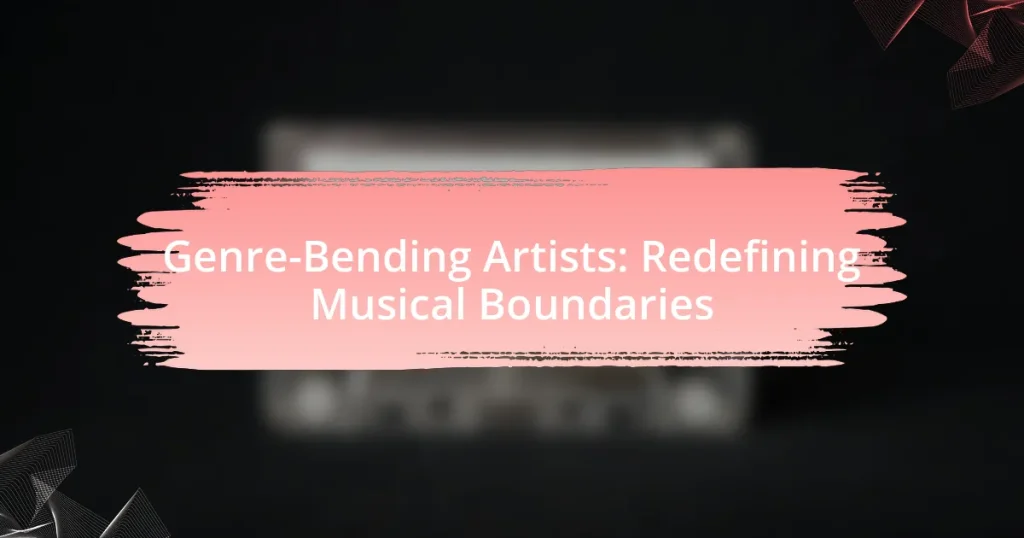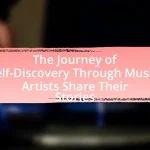Genre-bending artists are musicians who creatively blend elements from multiple musical genres, resulting in innovative sounds that challenge traditional classifications. This article explores the characteristics that define genre-bending artists, such as their ability to merge diverse styles like pop, hip-hop, and electronic music, exemplified by artists like Billie Eilish and Lil Nas X. It also examines the impact of genre-bending on the music industry, including the cultural shifts that have facilitated this trend, the challenges these artists face in mainstream acceptance, and the opportunities for reaching wider audiences. Additionally, the article highlights practical strategies for aspiring genre-bending artists to effectively blend genres and build their brand in a rapidly evolving musical landscape.
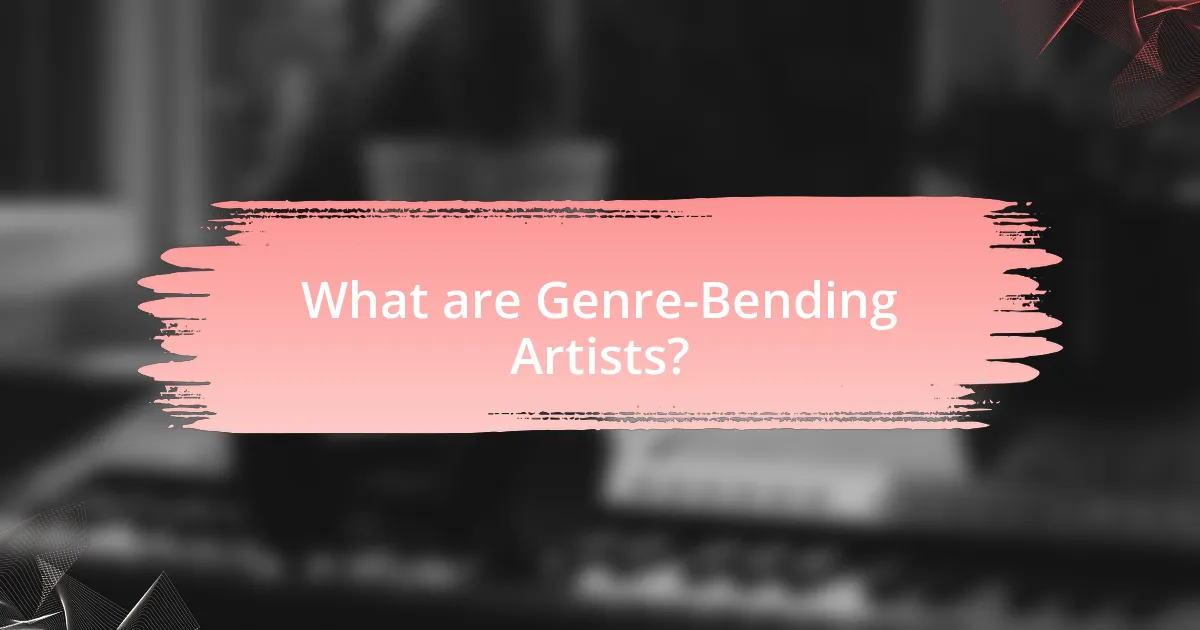
What are Genre-Bending Artists?
Genre-bending artists are musicians who blend elements from multiple musical genres to create innovative and unique sounds. This approach challenges traditional genre classifications, allowing for a more fluid and diverse musical landscape. For example, artists like Billie Eilish combine pop with electronic and indie influences, while Lil Nas X merges country with hip-hop, showcasing the versatility and creativity inherent in genre-bending. Such artists often attract diverse audiences and contribute to the evolution of music by breaking down barriers between genres.
How do Genre-Bending Artists differ from traditional musicians?
Genre-bending artists differ from traditional musicians primarily in their approach to musical styles, as they blend multiple genres to create innovative sounds rather than adhering to a single genre. Traditional musicians typically focus on established genres, following conventional structures and norms, while genre-bending artists experiment with cross-genre influences, resulting in unique compositions that challenge genre classifications. For example, artists like Billie Eilish and Lil Nas X incorporate elements from pop, hip-hop, and electronic music, showcasing versatility and creativity that diverges from the more rigid frameworks of traditional music. This blending not only expands the sonic palette but also reflects evolving cultural trends and listener preferences in contemporary music.
What characteristics define a Genre-Bending Artist?
A Genre-Bending Artist is defined by their ability to blend multiple musical styles and genres into a cohesive sound. These artists often incorporate elements from diverse genres such as rock, hip-hop, jazz, electronic, and pop, creating innovative and unique compositions. For instance, artists like Billie Eilish and Lil Nas X exemplify this characteristic by merging pop with electronic and country influences, respectively. This blending not only showcases their versatility but also challenges traditional genre classifications, reflecting a broader cultural shift in music consumption and production.
How do Genre-Bending Artists influence musical styles?
Genre-bending artists influence musical styles by merging elements from different genres, creating innovative sounds that challenge traditional boundaries. For example, artists like Billie Eilish blend pop with electronic and indie influences, resulting in a unique sonic identity that has reshaped mainstream music. This fusion encourages other musicians to experiment with diverse styles, leading to the emergence of new subgenres and collaborations. The impact is evident in the rise of hybrid genres such as trap-pop and country-rap, which have gained significant popularity and commercial success, demonstrating how genre-bending artists drive evolution within the music industry.
Why is the concept of genre-bending important in music today?
The concept of genre-bending is important in music today because it fosters innovation and creativity, allowing artists to explore new sounds and reach diverse audiences. By blending elements from different genres, musicians can break traditional boundaries, leading to the emergence of unique styles that resonate with listeners across various demographics. For instance, artists like Billie Eilish and Lil Nas X have successfully combined pop, hip-hop, and country influences, resulting in chart-topping hits that challenge conventional genre classifications. This trend not only reflects the evolving nature of music consumption in the digital age but also encourages collaboration among artists from different backgrounds, ultimately enriching the musical landscape.
What cultural shifts have contributed to the rise of genre-bending?
The rise of genre-bending has been significantly influenced by the cultural shift towards globalization and the digital revolution. Globalization has facilitated the cross-pollination of musical styles from diverse cultures, allowing artists to blend elements from various genres seamlessly. For instance, the accessibility of world music through streaming platforms has enabled artists to incorporate influences from hip-hop, jazz, electronic, and traditional music from different regions, creating hybrid sounds. Additionally, the digital revolution has democratized music production and distribution, empowering independent artists to experiment with genre combinations without the constraints of traditional music industry gatekeepers. This shift is evidenced by the success of artists like Billie Eilish and Lil Nas X, who have effectively merged pop, rap, and electronic elements, reflecting a broader acceptance of genre fluidity in contemporary music.
How does genre-bending reflect societal changes?
Genre-bending reflects societal changes by illustrating the fluidity of cultural identities and the breaking down of traditional boundaries. As society becomes more interconnected through globalization and technology, artists blend genres to express diverse influences and experiences, showcasing a shift towards inclusivity and hybridization in music. For instance, the rise of artists like Lil Nas X, who combines country and hip-hop, highlights changing perceptions of genre and identity, reflecting broader societal movements towards acceptance and diversity. This trend indicates a departure from rigid classifications, mirroring the evolving nature of cultural norms and values in contemporary society.
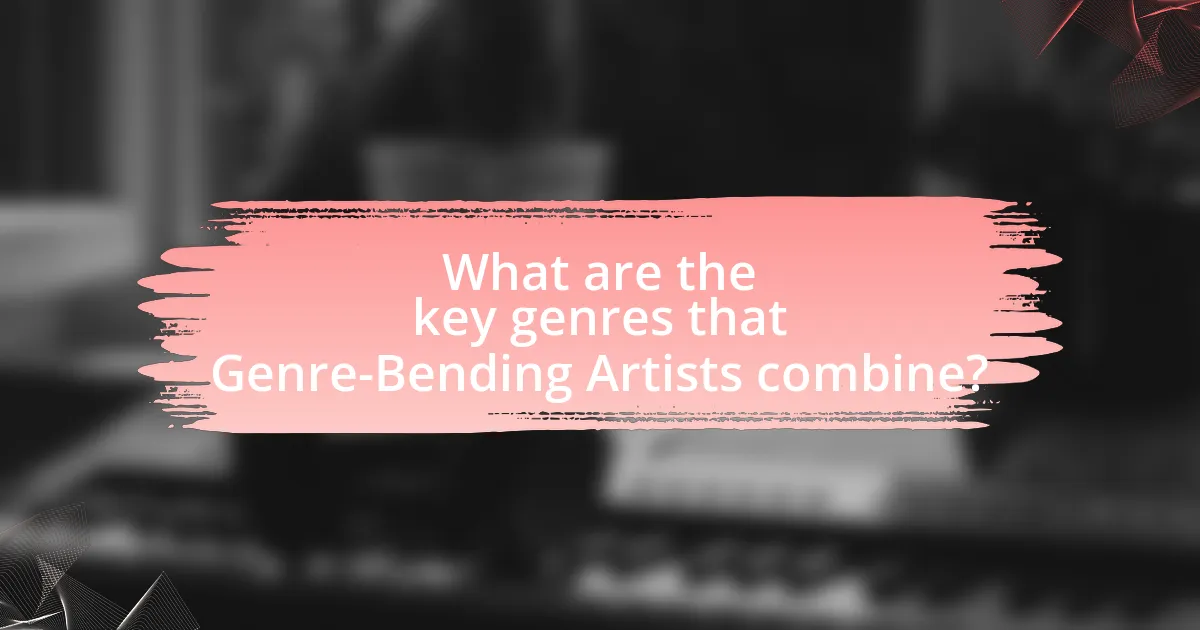
What are the key genres that Genre-Bending Artists combine?
Genre-bending artists combine various key genres, including pop, rock, hip-hop, electronic, jazz, and country. These artists often blend elements from multiple genres to create innovative sounds that challenge traditional musical boundaries. For instance, the fusion of hip-hop and rock can be seen in the works of artists like Kid Rock, while the combination of electronic and jazz is exemplified by artists such as Flying Lotus. This genre-blending approach not only reflects diverse musical influences but also caters to a wider audience, as evidenced by the commercial success of cross-genre collaborations in recent years.
Which genres are most commonly fused by Genre-Bending Artists?
Genre-bending artists most commonly fuse genres such as hip-hop, rock, pop, electronic, and jazz. These artists often blend elements from these genres to create innovative sounds, as seen in the works of musicians like Lil Nas X, who combines country and hip-hop, and Billie Eilish, who merges pop with electronic and alternative influences. This fusion reflects a growing trend in the music industry where traditional genre boundaries are increasingly blurred, allowing for diverse musical expressions and collaborations.
What are some notable examples of genre combinations?
Notable examples of genre combinations include country rap, which merges elements of country music with hip-hop, exemplified by artists like Lil Nas X with his hit “Old Town Road.” Another significant combination is jazz fusion, blending jazz with rock, funk, and R&B, as seen in the works of Miles Davis and Weather Report. Additionally, pop-punk combines pop music with punk rock, popularized by bands like Blink-182 and Paramore. These genre combinations illustrate the evolving nature of music, where artists draw from multiple influences to create innovative sounds.
How do these combinations create new musical experiences?
Combinations of different musical genres create new musical experiences by blending diverse elements, resulting in innovative sounds and emotional expressions. For instance, genre-bending artists like Billie Eilish and Lil Nas X merge pop, hip-hop, and electronic music, which attracts a wider audience and challenges traditional genre classifications. This fusion not only enhances creativity but also reflects cultural shifts, as seen in the rise of cross-genre collaborations that have led to chart-topping hits. The impact of these combinations is evident in the Billboard charts, where genre-blending tracks frequently dominate, showcasing their popularity and the evolving landscape of music consumption.
What role do technology and production play in genre-bending?
Technology and production are crucial in genre-bending as they enable artists to blend diverse musical styles seamlessly. Advanced digital tools, such as software for music production and sound manipulation, allow musicians to experiment with various genres, creating innovative sounds that defy traditional classifications. For instance, the use of sampling technology has facilitated the incorporation of elements from hip-hop, electronic, and rock into a single track, exemplified by artists like Billie Eilish and Lil Nas X, who utilize production techniques that merge pop with other genres. This technological integration not only enhances creativity but also broadens the audience’s listening experience, as evidenced by the rise of genre-blurring playlists on streaming platforms, which reflect the growing popularity of such hybrid music forms.
How has technology enabled genre-bending in music production?
Technology has enabled genre-bending in music production by providing artists with advanced tools for sound manipulation and integration across diverse musical styles. Digital audio workstations (DAWs) allow for seamless layering of different genres, while software synthesizers and samplers facilitate the blending of unique sounds from various musical traditions. Additionally, the rise of online collaboration platforms enables artists from different backgrounds to work together, further promoting genre fusion. The accessibility of production technology has democratized music creation, allowing independent artists to experiment with and combine genres without the constraints of traditional studio environments.
What tools are essential for Genre-Bending Artists?
Essential tools for genre-bending artists include digital audio workstations (DAWs), synthesizers, and collaboration platforms. DAWs like Ableton Live and Logic Pro enable artists to blend various musical styles seamlessly, while synthesizers provide a wide range of sounds that can be manipulated to create unique textures. Collaboration platforms such as Splice facilitate interaction with other musicians, allowing for diverse influences and ideas to merge, which is crucial for genre-bending creativity. These tools collectively empower artists to explore and redefine musical boundaries effectively.
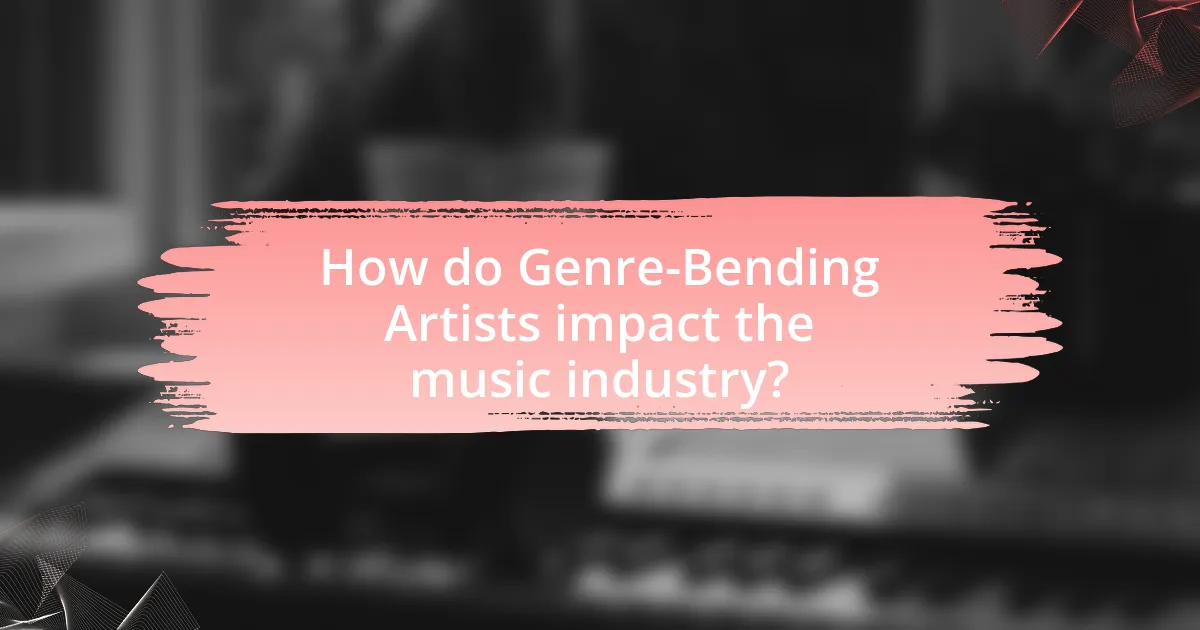
How do Genre-Bending Artists impact the music industry?
Genre-bending artists significantly impact the music industry by challenging traditional genre classifications and expanding the creative possibilities for musicians. These artists, such as Billie Eilish and Lil Nas X, blend elements from various genres, leading to innovative sounds that attract diverse audiences. This blending not only influences mainstream music trends but also encourages record labels to embrace a wider range of styles, resulting in increased collaboration across genres. For instance, the success of genre-bending tracks often leads to higher streaming numbers and chart placements, as seen with Lil Nas X’s “Old Town Road,” which topped the Billboard Hot 100 for 19 weeks, demonstrating the commercial viability of genre fusion. Consequently, genre-bending artists play a crucial role in reshaping the music landscape, driving both artistic evolution and market dynamics.
What challenges do Genre-Bending Artists face in the industry?
Genre-bending artists face significant challenges in the industry, primarily due to market categorization and audience expectations. The music industry often relies on established genres for marketing and promotion, making it difficult for artists who blend styles to find their niche. For instance, a study by the University of Southern California found that genre-specific playlists dominate streaming platforms, limiting exposure for artists who do not fit neatly into one category. Additionally, genre-bending artists may struggle with identity and branding, as they must navigate the expectations of multiple fan bases while trying to maintain their unique sound. This complexity can lead to difficulties in securing record deals and radio play, as traditional gatekeepers may be hesitant to invest in artists who defy conventional genre classifications.
How do record labels respond to genre-bending artists?
Record labels often embrace genre-bending artists as they represent innovative potential and marketability. By signing these artists, labels can tap into diverse fan bases and expand their reach across multiple genres, which can lead to increased sales and streaming numbers. For instance, the rise of artists like Lil Nas X, who blends country and hip-hop, has demonstrated how genre fusion can create viral hits and attract attention from various demographics, resulting in significant commercial success. This adaptability allows record labels to stay relevant in a rapidly changing music landscape, where traditional genre boundaries are increasingly blurred.
What barriers exist for genre-bending artists in mainstream acceptance?
Genre-bending artists face significant barriers to mainstream acceptance primarily due to rigid industry categorization and audience expectations. The music industry often relies on established genres for marketing and promotion, which can marginalize artists who do not fit neatly into these predefined categories. For instance, Billboard charts categorize music by genre, making it challenging for genre-bending artists to gain visibility and traction. Additionally, audiences may have preconceived notions about what constitutes a specific genre, leading to resistance against innovative sounds that blend multiple styles. This resistance is evident in the limited radio play and streaming playlists available to artists who defy traditional genre boundaries, ultimately hindering their ability to reach wider audiences.
What opportunities arise from genre-bending in the music market?
Genre-bending in the music market creates opportunities for artists to reach diverse audiences and innovate creatively. By blending different musical styles, artists can attract fans from multiple genres, thereby expanding their listener base. For instance, the rise of artists like Lil Nas X, who fused country and rap, led to significant chart success and increased visibility across various demographics. This cross-genre appeal can also result in collaborations with artists from different backgrounds, further enhancing creativity and marketability. Additionally, genre-bending allows for the exploration of new sounds and themes, which can lead to unique branding opportunities and increased media attention, as seen with the success of Billie Eilish, who incorporates elements from pop, electronic, and alternative music.
How can Genre-Bending Artists reach wider audiences?
Genre-bending artists can reach wider audiences by leveraging digital platforms and social media to promote their unique sound. These artists often utilize streaming services like Spotify and Apple Music, which allow for genre-specific playlists that can introduce their music to diverse listener bases. Additionally, engaging with fans through social media platforms such as Instagram and TikTok enables them to create viral content that showcases their genre-blending style, attracting attention from various music communities. According to a 2021 report by the International Federation of the Phonographic Industry, 70% of music listeners discover new artists through streaming platforms, highlighting the effectiveness of this approach.
What trends are emerging from the success of genre-bending artists?
The success of genre-bending artists is leading to increased collaboration across diverse musical styles. This trend is evident as artists from different genres, such as hip-hop, rock, and electronic music, are increasingly working together, resulting in innovative sounds that attract wider audiences. For instance, the collaboration between Lil Nas X and Billy Ray Cyrus on “Old Town Road” exemplifies how blending country and rap can create viral hits, breaking traditional genre barriers. Additionally, streaming platforms are promoting genre diversity by using algorithms that recommend music outside of users’ typical preferences, further encouraging listeners to explore hybrid genres. This shift not only expands the musical landscape but also reflects changing consumer behaviors that favor eclecticism over rigid genre classifications.
What are some practical tips for aspiring Genre-Bending Artists?
Aspiring genre-bending artists should actively explore diverse musical styles and influences to create unique sounds. Engaging with various genres allows artists to identify elements that resonate with them, fostering innovation. Collaborating with musicians from different backgrounds can also enhance creativity, as it introduces new perspectives and techniques. Additionally, studying successful genre-benders, such as Billie Eilish and Lil Nas X, reveals the importance of authenticity and experimentation in their work. These artists often blend pop, hip-hop, and electronic elements, demonstrating that crossing boundaries can lead to commercial success and artistic fulfillment.
How can artists effectively blend genres in their music?
Artists can effectively blend genres in their music by experimenting with diverse musical elements, such as rhythm, melody, and instrumentation, to create a unique sound. This approach allows artists to draw inspiration from various genres, enabling them to combine characteristics like the syncopation of jazz with the beats of hip-hop or the harmonies of folk with electronic music. Historical examples include artists like Beck, who incorporates elements from rock, hip-hop, and folk, and Billie Eilish, who merges pop with electronic and alternative influences. These artists demonstrate that genre blending can lead to innovative music that resonates with a broader audience, showcasing the versatility and creativity inherent in the art form.
What strategies can help Genre-Bending Artists build their brand?
Genre-bending artists can build their brand by leveraging social media platforms to showcase their unique sound and engage with diverse audiences. Utilizing platforms like Instagram, TikTok, and YouTube allows these artists to share snippets of their music, behind-the-scenes content, and personal stories, which fosters a deeper connection with fans. Additionally, collaborating with artists from different genres can expand their reach and introduce their music to new listener demographics. According to a 2021 report by the International Federation of the Phonographic Industry, artists who engage in cross-genre collaborations often see a significant increase in streaming numbers and fan engagement. Furthermore, participating in live performances and festivals that celebrate genre diversity can enhance visibility and solidify their presence in the music industry.
